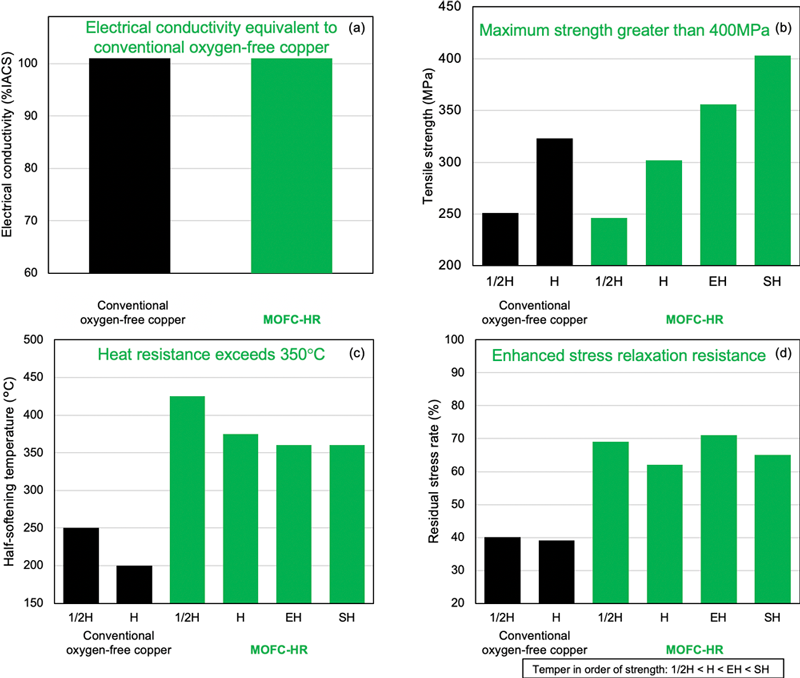News
October 1, 2021
September 27, 2021
Mitsubishi Materials Corporation
Development of "MOFC-HR" (HR: Heat Resistance)
Oxygen-Free Copper with the World's Highest Standard in Strength and Heat Resistance
Mitsubishi Materials Corporation has developed "MOFC*1-HR" (Mitsubishi Oxygen-Free Copper - Heat Resistance), an entirely new oxygen-free copper with strength and heat resistance enhanced to the world's highest level.
With the spread of EV and next-generation energy, electrical components are being required to accommodate large currents and offer high heat dissipation. Oxygen-free copper, which has the highest electrical and thermal conductivity of all copper materials, is rapidly expanding its presence in the industry, yet the low strength and heat resistance properties limit its use when strength is required from size reduction, when material temperature rises due to large current, or when heat treatment is required during manufacturing.
Mitsubishi Materials has combined its core technology in manufacturing high-quality oxygen-free copper with its material design technology to successfully develop "MOFC-HR", an oxygen-free copper with enhanced strength and heat resistance while maintaining high electrical and thermal conductivity.
"MOFC-HR" features very high strength compared with conventional oxygen-free copper (403MPa, approximately 25% increase) with significantly improved heat resistance (half-softening temperature*2 of 350℃ or higher, approximately 150℃ improvement) and stress relaxation resistance*3 (residual stress ratio of 60% or more, approximately twice the improvement), all with equivalent electrical conductivity (101%IACS) and thermal conductivity (391W/mK). Being less vulnerable to degradation in high heat environments enables it to be used in a wide range of applications, and ideal for electrical components for EV and next-generation energy applications that are required to accommodate large currents and offer high heat dissipation in harsh environmental conditions.
"MOFC-HR" is registered as "C10850" with the CDA (Copper Development Association).
(a) Electrical conductivity, (b) Tensile strength, (c) Half-softening temperature, (d) Residual stress rate
 (Click the picture to see the enlarged image)
(Click the picture to see the enlarged image)
 (Click the picture to see the enlarged image)
(Click the picture to see the enlarged image)
The vision of the Mitsubishi Materials Group is to "become the leading business group committed to creating a sustainable world through materials innovation, with use of our unique and distinctive technologies" based on its corporate philosophy of "For People, Society and the Earth." Mitsubishi Materials will continue to help build a more abundant society through developing and supplying nonferrous metal materials and high-value-added products.
- *1
- "MOFC" is a trademark of Mitsubishi Materials Corporation.
- *2
- Half-softening temperature
Half-softening temperature is an indicator of heat resistance. It is the heat treatment temperature at which the strength is the mean of the strength "before heat treatment" and "after full annealing". The higher the half-softening temperature, the higher the ability to maintain strength after heat treatment. - *3
- Stress relaxation resistance
Stress relaxation resistance is a characteristic indicating resilience of a spring. A load within the elasticity range (80% of 0.2% proof stress) is applied to the material and held at 180℃ for 24 hours. The strength remaining after heat treatment is evaluated as residual stress rate. A spring with higher stress relaxation resistance is less vulnerable to weakening by high temperature use as the spring force is sufficiently maintained.
<Contact details for inquiries>
Public Relations Dept., Corporate Communication Dept.
+81-3-5252-5206